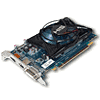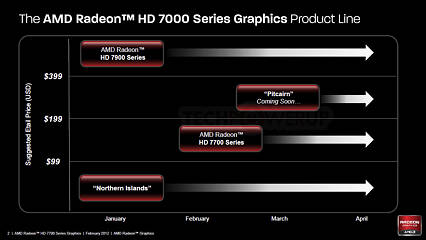 12
12
HIS Radeon HD 7750 iCooler 1 GB Review
Packaging & Contents »Introduction

Launched amongst much fanfare earlier this year, It's now time for AMD's Graphics CoreNext architecture to get down to serious business: driving a mainstream GPU that offers killer value at price-points which most people will end up buying. AMD today launched the Radeon HD 7700 series, based on its spanking new silicon codenamed "Cape Verde".
What makes this launch a particularly monumental challenge for Graphics CoreNext is that it now has to deliver on its biggest design goal, that of being a more efficient number-cruncher than previous-generation VLIW architecture. This efficiency is supposed to show in relative performance per mm² (taking the new 28 nm fab process into account), performance per Watt, and in more layman terms, performance to stream processor count.
But first, a little history lesson. AMD addressed the sub-$200 market with its first DirectX 11 generation of GPUs using the Radeon HD 5700 series, based on the 40 nm "Juniper" silicon. Since the following HD 6000 series was also based on this process, and AMD had achieved higher performance targets with "Barts", it decided to reshuffle the higher-end lineup, give Barts the HD 6800 series, and since Juniper was the only GPU smaller than Barts, re-brand it to the HD 6700 series, to everyone's disgust including ours. With the transition to the new 28 nm fab process and a new number-chomping architecture, Graphics CoreNext, designing a new GPU became inevitable for AMD. Hence, Cape Verde. Products based on this chip, the Radeon HD 7770 and Radeon HD 7750, are touted to be true successors of the HD 6700 series.
Architecture
Cape Verde is a downscale from the “Tahiti” silicon, on which higher Radeon HD 7900 series parts are based. There are fewer number of redundant components, so Cape Verde is left functionally-identical to Tahiti, but is smaller, built for more affordable graphics cards. Tahiti also retains the basic hierarchy of the architecture as implemented in Tahiti. A command processor takes input from the host machine, decodes them, and does the groundwork for the number-crunching area, the Graphics CoreNext clusters, which then perform all the shader and math-intensive processing. The Raster Operations area does the final leg of the processing, and the information is forwarded to the display logic. All components are interconnected to an L2 cache, that works as a very fast scratchpad for the GPU, and of course, the memory controllers.Cape Verde has 10 Graphics CoreNext Computing Units (GCN CUs), which total up 640 stream processors. The Radeon HD 7750 is carved out of the Cape Verde silicon by enabling eight out of ten GCN CUs, leaving us with 512 stream processors. The chip has 32 TMUs, and 16 ROPs. It features a 128-bit wide GDDR5 memory interface, with which it communicates with 1 GB of memory. The chip retains the display logic of Tahiti, which lets you connect up to 6 displays in Eyefinity for productivity usage.
The GPU also features PCI-Express Gen. 3.0 support, which increases bandwidth between it and the rest of the system. While we doubt the chip really needs 32 GB/s of system bandwidth, PCIe Gen 3.0 could come handy when connected in configurations with lower number of PCIe lanes (such as x8, x4, or even x1), as PCIe Gen 3.0 has more bandwidth per lane.
With the new HD 7000 series, AMD also introduced what it refers to as ZeroCore Technology. Simply put, this feature reduces power consumption of the GPU down to zero, by gating power to it, when the system is idling for extended periods of time, when the displays are blanked. In this power state, the graphics card draws less than 3W of power, making it extremely energy-efficient. The typical board power figures for the Radeon HD 7700 GPUs are also claimed by its makers to be extremely low.
HIS Radeon HD 7750 iCooler 1 GB

HIS implemented the Radeon HD 7750 with its familiar-looking iCooler graphics card design. It uses a compact PCB with its signature shade of blue, topped of with a fan-heatsink made by Arctic Cooling, which HIS used on several other cards.
We also have the following reviews for you today:
- AMD Radeon HD 7770 (reference design)
- HD 7750 & HD 7770 in CrossFire
- ASUS Radeon HD 7770 DirectCU Review (custom cooler & overclocked)
- MSI Radeon HD 7770 OC (custom cooler & overclocked)
- PowerColor Radeon HD 7770 (custom cooler)
- XFX Radeon HD 7770 Black Edition Super OC Review (custom cooler & overclocked)
| Radeon HD 5750 | Radeon HD 5770 | Radeon HD 7750 | GeForce GTX 550 Ti | Radeon HD 6790 | Radeon HD 6850 | GeForce GTX 460 | GeForce GTX 460 | Radeon HD 6870 | Radeon HD 7770 | GeForce GTX 560 | |
|---|---|---|---|---|---|---|---|---|---|---|---|
| Shader Units | 720 | 800 | 512 | 192 | 800 | 960 | 336 | 336 | 1120 | 640 | 336 |
| ROPs | 16 | 16 | 16 | 24 | 16 | 32 | 24 | 32 | 32 | 16 | 32 |
| Graphics Processor | Juniper | Juniper | Cape Verde | GF116 | Barts | Barts | GF104 | GF104 | Barts | Cape Verde | GF114 |
| Transistors | 1040M | 1040M | 1500M | 1170M | 1700M | 1700M | 1950M | 1950M | 1700M | 1500M | 1950M |
| Memory Size | 1024 MB | 1024 MB | 1024 MB | 1024 MB | 1024 MB | 1024 MB | 768 MB | 1024 MB | 1024 MB | 1024 MB | 1024 MB |
| Memory Bus Width | 128 bit | 128 bit | 128 bit | 192 bit | 256 bit | 256 bit | 192 bit | 256 bit | 256 bit | 128 bit | 256 bit |
| Core Clock | 700 MHz | 850 MHz | 800 MHz | 900 MHz | 840 MHz | 775 MHz | 675 MHz | 675 MHz | 900 MHz | 1000 MHz | 810 MHz |
| Memory Clock | 1150 MHz | 1200 MHz | 1125 MHz | 1026 MHz | 1050 MHz | 1000 MHz | 900 MHz | 900 MHz | 1050 MHz | 1125 MHz | 1002 MHz |
| Price | $110 | $105 | $110 | $120 | $125 | $135 | $140 | $140 | $155 | $160 | $170 |
Apr 25th, 2024 06:46 EDT
change timezone
Latest GPU Drivers
New Forum Posts
- Core i5-6300U (16)
- Share your AIDA 64 cache and memory benchmark here (2916)
- Last game you purchased? (254)
- What phone you use as your daily driver? And, a discussion of them. (1472)
- What's your latest tech purchase? (20338)
- Meta Horizon OS (16)
- (Anti) SFF fun house (351)
- Alphacool CORE 1 CPU block - bulging with danger of splitting? (4)
- The TPU UK Clubhouse (24786)
- Github comments used to push malware via Microsoft repo urls (3)
Popular Reviews
- Fractal Design Terra Review
- Thermalright Phantom Spirit 120 EVO Review
- Corsair 2000D Airflow Review
- Minisforum EliteMini UM780 XTX (AMD Ryzen 7 7840HS) Review
- ASUS GeForce RTX 4090 STRIX OC Review
- NVIDIA GeForce RTX 4090 Founders Edition Review - Impressive Performance
- ASUS GeForce RTX 4090 Matrix Platinum Review - The RTX 4090 Ti
- MSI GeForce RTX 4090 Suprim X Review
- MSI GeForce RTX 4090 Gaming X Trio Review
- Gigabyte GeForce RTX 4090 Gaming OC Review
Controversial News Posts
- Sony PlayStation 5 Pro Specifications Confirmed, Console Arrives Before Holidays (116)
- NVIDIA Points Intel Raptor Lake CPU Users to Get Help from Intel Amid System Instability Issues (106)
- AMD "Strix Halo" Zen 5 Mobile Processor Pictured: Chiplet-based, Uses 256-bit LPDDR5X (101)
- US Government Wants Nuclear Plants to Offload AI Data Center Expansion (98)
- Windows 11 Now Officially Adware as Microsoft Embeds Ads in the Start Menu (84)
- Windows 10 Security Updates to Cost $61 After 2025, $427 by 2028 (84)
- Developers of Outpost Infinity Siege Recommend Underclocking i9-13900K and i9-14900K for Stability on Machines with RTX 4090 (84)
- AMD's RDNA 4 GPUs Could Stick with 18 Gbps GDDR6 Memory (80)



